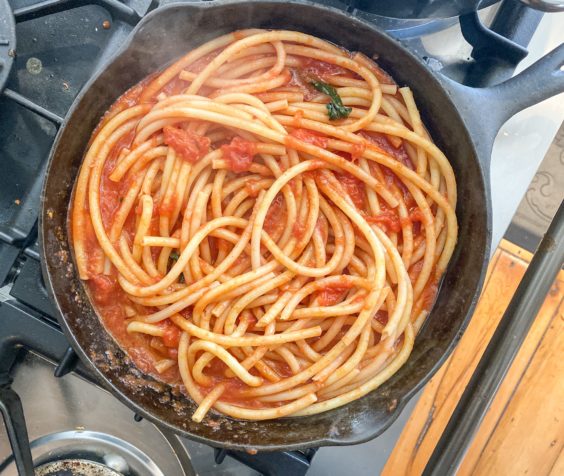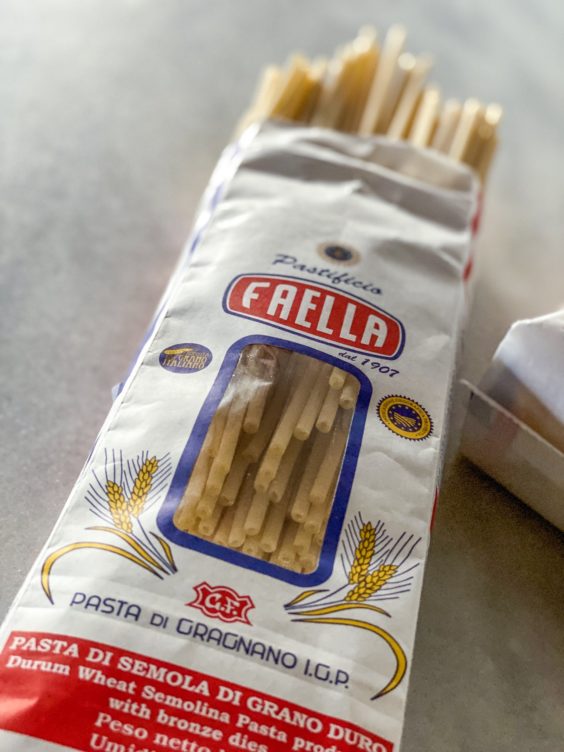
The year was 1921, the place Ellis Island. My maternal grandmother, single, arrives into port from Napoli on the ship Patria to be with her sister Concetta, living in Brooklyn. My grandfather, who had come to America in 1911 from Marche, had recently lost his young wife to the 1918 flu epidemic and needed a mother for his then 5-year-old son Nelson. They somehow found each other in the sea of Italian immigrants that had arrived in the new world. They married in 1924.
My grandmother, Maria, grew up on the beautiful Bay of Naples. My grandfather told her he also lived on the water here in America. However, his body of water was the Delaware River that divides NJ and Pennsylvania, a far cry from the immense beauty of bay in Italy. She told that story often, with a chuckle. Together, they made it work – they went on to have 3 children together (my father the middle child) and they died within a year of each other in the late 60s.

My mother, although of Sicilian descent, quickly learned and mastered all the recipes of my grandmother’s Neapolitan childhood to cook for my father. She became the cook of the extended family, turning out homemade pasta, pot after pot of Sunday sauce, eggplant parmesan for family and friends near and far.
We have been doing a lot of digging recently into our family history. Naples for me was always a place of interest but honestly not top of my list to visit again. As we began to dig into family details, the story of my grandmother’s upbringing in Naples began to take shape and I found myself reading and watching everything I could get my hands on regarding the history of Naples, its culture and the food. (More on all this in our upcoming newsletter!) The dishes of our childhood grace the pages of so many cookbooks on Naples and Campania. Yet there Is so much to learn and understand about the cooking of this region – so very exciting to open my eyes wide to a region of Italy that holds such meaning for our family.
The soil in Campania, specifically around the infamous volcano, Vesuvius, is incredibly fertile. Waverley Root in his ‘The Food of Italy’ states that legend has it that Neapolitan sailors first brought the seeds of the tomato from Peru and they grew healthy and robust in the rich soil of Naples. Today, the San Marzano tomato reigns supreme. Doing all this research left me hungry to make a pasta dish made throughout the region – a very simple tomato sauce made from canned San Marzanos, simmered for a brief period with a garlic-infused olive oil and basil – allowing the magical and pure taste of the beautiful San Marzanos to shine through. I don’t always use extra virgin olive oil to cook but in this case, given how few ingredients make up the sauce and the quality of the other ingredients, I highly recommend breaking out the good stuff. Hot on the Neapolitan food trail, I also purchased pasta from Neapolitan Pastificio Faella established in 1907, turning out delicious pasta made from the wheat of Gragnano (the birthplace of Italian dried pasta) and the spring waters of the Lattari Mountains.
This sugo di pomodoro is as easy as it comes – yet the ingredients, in their simplicity, allows the flavors of the tomatoes and the wheat to work their magic in your mouth. Seek out the ingredients if you can find them, open that bottle of vino, toss the dish together in under 30 minutes and enjoy these simple, magical pleasures from nature.

Buon appetito!
Michele


Neapolitan Sugo di Pomodoro
Description
The simplest of tomato sauces that allow the flavors of the ingredients to shine through – and comes together within 30 minutes. Keeper!
Ingredients
- 2 tablespoons extra virgin olive oil
- 2 or 3 medium cloves garlic, peeled and lightly smashed
- 1 (28-ounce) can San Marzano tomatoes
- Kosher salt
- Red pepper flakes
- A few leaves of basil
- Extra-virgin olive oil and a few basil leaves to finish
- 1 pound pasta (preferably made from Gragnano wheat)
Instructions
Pick a saucepan large enough to hold all the pasta and sauce. I use my large cast iron skillet. Add the olive oil and garlic cloves to the pan. Warm over medium low heat. Allow the garlic to slowly simmer in the oil until lightly browned, 3-5 minutes. Remove the garlic from the pan.
Raise the heat to medium. Add the can of tomatoes with their juice to the pan. Some cooks prefer to drain the tomatoes which results in a thicker sauce. Either way is fine. Add a few large pinches of salt to the sauce, a pinch of red pepper flakes and a few leaves of basil. Gently push on the tomatoes with a wooden spoon to break up the tomatoes in the sauce. Allow the sauce to simmer and thicken slightly. Taste and add additional salt if necessary.
Meanwhile, put up a large pot of salted (like the sea!) water to cook the pasta. Be at the ready to transfer the pasta into the sauce pan as you will only cook the pasta for a few minutes in the water. When it comes to a boil, drop in the pasta. Note how long the package says to cook the pasta until al dente and only cook it for half that time in the water. Transfer the pasta to the sauce pan to finish cooking. (For example, if the package says 8 minutes for al dente, transfer it to the sauce at around 4 minutes.) Finish cooking the pasta to al dente in the sauce. The pasta will continue to cook in the sauce releasing a bit of starch and helping to thicken the sauce. Feel free to add a little bit of the pasta cooking water to the pan if the sauce is too dry.
When done, transfer the pasta and sauce to a heated serving bowl. Sprinkle with a few fresh basil leaves and a drizzle of extra virgin olive oil and serve! (Some Neapolitans would balk at serving grated cheese with this dish as it muddles the pure flavors of the dish. I say try it first without add only if you feel you need to!) Enjoy!




Buongiorno
Beyond the enjoyable read in your web site with personal family pictures are the records of the property left behind in Sicily. Our office in San Francisco is connected to the Italian Gov. data base of all unclaimed, forgotten properties of which there are 1000s. The children of immigrants and their issues may claim property according to Italian law.
If you send our office the Concettta’s maiden name, date of birth, Italian town of birth, we will find her or others in the data base. You may add other names. We will check and get back to you indicating the exact location, size of the property, etc. To look up 2-3 names is free. Leave your phone number in Italy the LA office so we can call you if necessary
Distinti saluti
I am suprised that this has not been rated yet! I stumbled across this site wuit by accident. The sauce is as authentic as I remember ! What I love most about true Italian cooking is the simplicity and keeping the quality of the ingredients pure and fresh.
I have not seen pasta made with gragnano wheat here in the states. Do you sell it, or have tips on where I can find it ?
Grazie Joanne! I do buy ours from one of my favorite sites – Gustiamo https://www.gustiamo.com/big-bag-bucatini-faella/